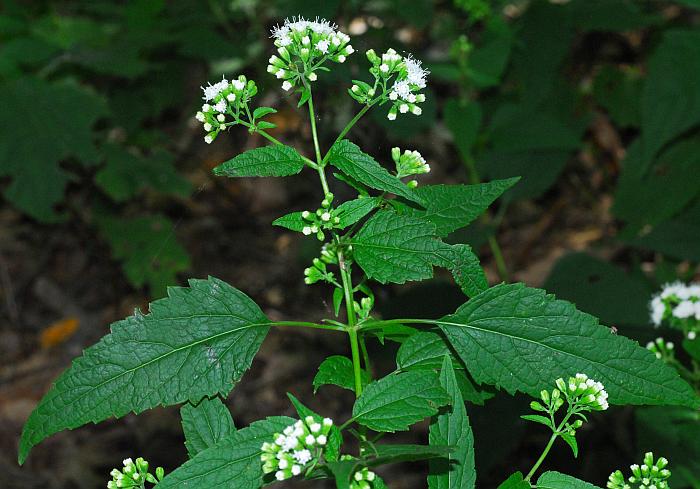Ageratina altissima (L.) R.M. King & H. Rob.
White Snakeroot

Native
CC = 2
CW = 3
MOC = 91
© SRTurner
Ageratina altissima (L.) R.M. King & H. Rob.White Snakeroot | |
 |
Native CC = 2 CW = 3 MOC = 91 |
© SRTurner |
|
Family - Asteraceae/Eupatorieae Habit - Fibrous-rooted perennial forb. Stems - Ascending to erect, usually solitary, to 1.5 m, glabrous or short-hairy, usually branched.
Leaves - Opposite, petiolate, simple. Blades to 18 cm, triangular or triangular-ovate, the uppermost often narrowed, sharply pointed, the margins broadly toothed, the surfaces glabrous or sparsely hairy, with 3 main veins. Main venation is adaxially impressed, abaxially expressed.
Inflorescence - Panicles at branch tips, flat-topped to convex.
Heads - Discoid, with 9-25 florets. Involucre 3-5 mm long, cup-shaped, the bracts 8-14 in usually 2 unequal, overlapping series, linear to narrowly oblong-elliptic, bluntly or sharply pointed, glabrous or finely short-hairy, sometimes only along the margins. Receptacle flat or nearly so.
Florets - Corollas 5-lobed, white. Pappus of numerous capillary bristles.
Fruits - Achenes 1.7-3.0 mm long, 5-angled, somewhat wedge-shaped in profile to nearly linear, glabrous, brown to black.
Flowering - July - October. Habitat - Forest, streambanks, roadsides, open disturbed areas. Origin - Native to the U.S. Lookalikes - Eupatorium serotinum. Other info. - This plant is very common throughout the state, and throughout most of the eastern half of the U.S. When fresh, the flowering heads are pure white in color, and this along with the triangular leaves make this plant fairly easy to recognize. It is most easily confused with Eupatorium serotinum, which is typically a taller, less branched plant with dirtier-looking flower heads and shorter leaf petioles. In fact, Ageratina altissima was once classified as Eupatorium rugosum. The species has been subdivided into infraspecific forms, with all Missouri plants currently assignable to var. altissima. Photographs taken near Valmeyer, Monroe County, IL, 10-3-2011; near Glencoe, St. Louis County, MO, 10-31-2011; Shaw Nature Reserve, Franklin County, MO, 9-8-2012; and LaBarque Creek Conservation Area, Jefferson County, MO, 9-13-2012 (SRTurner). |